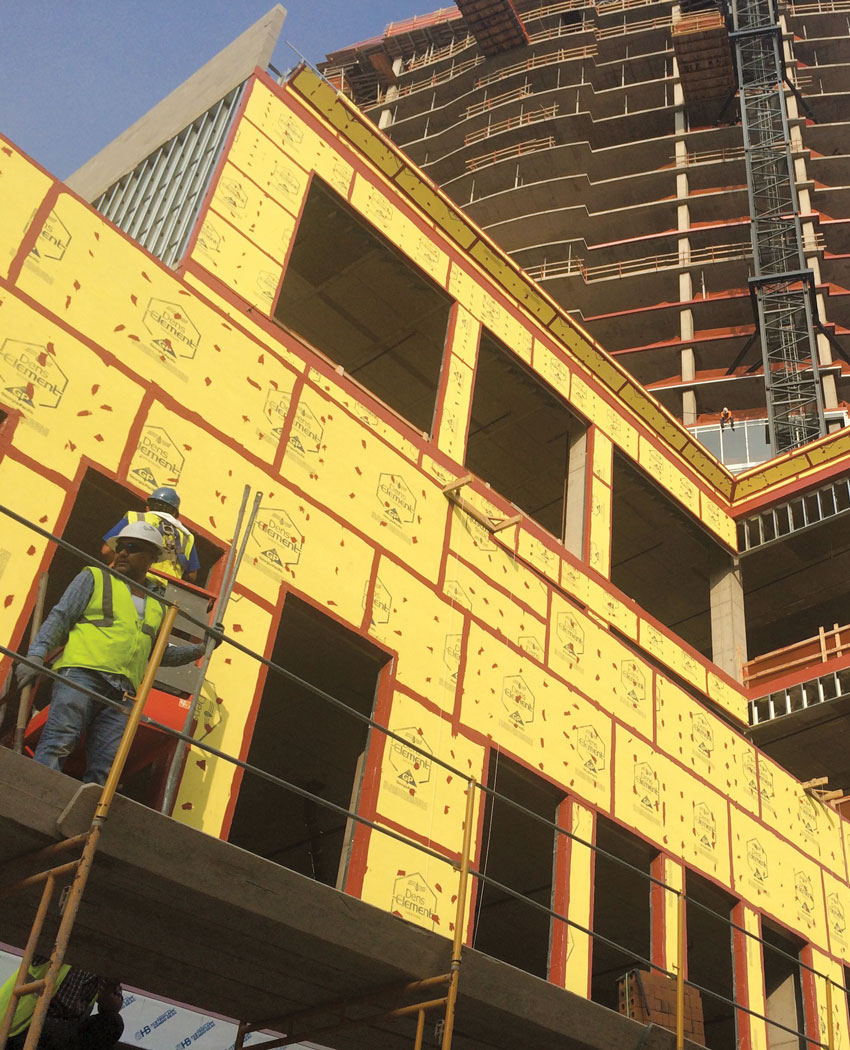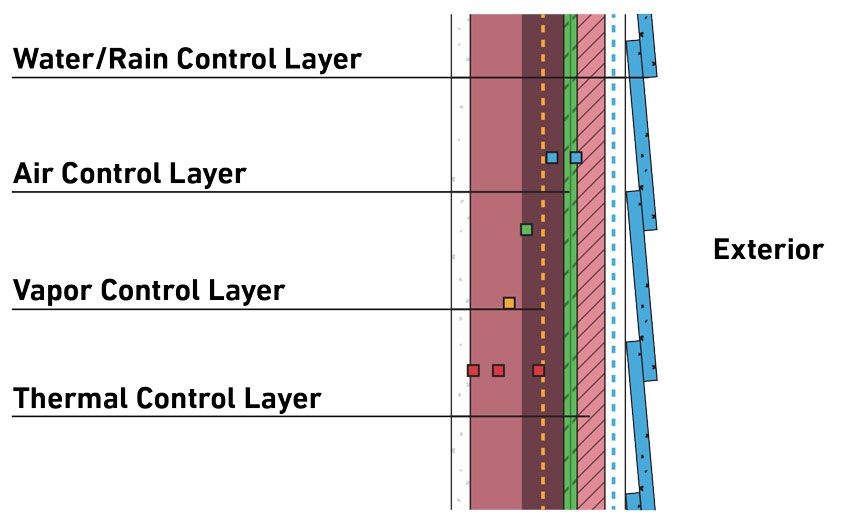The Evolution of Water-Resistive and Air Barriers in Commercial Building Envelope Construction
Learning Objectives:
- Explain the key functions required by building codes for water-resistive barriers, continuous air barriers, vapor retarders, and thermal barriers in a building envelope/enclosure.
- Describe the durability, resilience, energy efficiency, and advantages/disadvantages of various traditional WRB and AB systems, as well as the differences between all-in-one (integrated sheathing with WRB-AB) systems versus traditional WRB and AB systems.
- Describe the differences—in manufacturing and performance—between coated and fully integrated methods of all-in-one sheathing systems available in the marketplace today.
- Design with integrated sheathing products to achieve labor, material, and installation time savings in commercial building envelope construction.
Credits:
This course is approved as a Structured Course
This course can be self-reported to the AANB, as per their CE Guidelines
Approved for structured learning
Approved for Core Learning
This course can be self-reported to the NLAA
Course may qualify for Learning Hours with NWTAA
Course eligible for OAA Learning Hours
This course is approved as a core course
This course can be self-reported for Learning Units to the Architectural Institute of British Columbia
Commercial building envelopes have evolved in recent decades, driven in large part toward better performance for durability, resilience, and energy efficiency. Some of the motivation for these results has been driven by code requirements, others by green building standards, and some simply by owner demands for better performance, faster installation, and labor efficiencies. In response, a number of building products have used innovation backed up by performance testing to address the particular need to create the four barriers needed as part of any building enclosure, namely water-resistive barriers (WRBs), air barriers (ABs), thermal barriers, and vapor retarders. In particular, there has been a rapid acceleration of innovation in air barriers and water-resistive barriers recently.

All images courtesy of Georgia-Pacific Gypsum
Commercial buildings require continuous air and water-resistant barriers in order to meet codes. The means to provide those barriers has evolved since the 1960s with integrated solutions that save time and costs while delivering high performance.
Therefore, in this course, we will focus on helping architects get up to speed and stay abreast of some of the latest advances in these barriers. Of particular note, all-in-one, integrated gypsum sheathing systems will be looked at that include WRB and AB systems during manufacturing as alternatives to field-applied water- and air-barrier systems. These integrated systems can speed up installation and save time and money during construction. And, since they have been shown to reduce improper field installations, they provide greater reliability and less professional risk compared to separate field-applied solutions.
Code-Required Barriers to Protect the Building Envelope
Typically, each of the four common barriers in a building envelope have been treated independently by designers, contractors, and product manufacturers. Indeed, even the building codes address them individually, as we will here as follows.
Water-Resistive Barriers (WRBs)
This barrier is intended to do exactly what its name implies: resist bulk water from penetrating into a wall assembly from the exterior side. WRBs are specifically required by the International Building Code (IBC) and the International Residential Code (IRC) for the purpose of protecting the materials and components of a wall assembly from water that may penetrate past the exterior cladding. Without such protection, unwanted water penetration over time can intrude into the assembly, thus producing deterioration, degradation, and even failure, any of which can render a building unsafe or unhealthy for occupancy. To avoid those conditions, a properly tested WRB is typically called for behind the exterior cladding of a wall assembly on the face of the sheathing or similar surface. The wall assembly then needs to be designed to allow the WRB to function as a water-control layer by channeling water down its exterior face to drain harmlessly away to the exterior. In so doing, it reduces or eliminates potential water and moisture problems inside a wall assembly, particularly in cavity wall framed construction.

The four barriers, or control layers, of an exterior wall envelope all need to be understood independently of each other
Continuous Air Barriers (ABs)
This barrier has received a lot of attention in recent years since unwanted air infiltration has been seen as both a significant drain on energy performance and a means to transfer unwanted air-borne moisture into buildings. In particular, the International Energy Conservation Code (IECC) now has very specific, mandatory requirements for providing continuous air barriers in building envelopes aimed at restricting or preventing the passage of air in order to assure minimum levels of code required energy performance. The code leaves it to the architect to determine the best location of the AB, whether on an interior or exterior side of a construction assembly, but does indicate that it needs to follow the same line as the building thermal barrier. Its purpose is to essentially “wrap” the building shell to prevent air passing from the outside to the inside due to wind, building “stack effects,” or mechanical ventilation pressure differences. To achieve this in exterior walls, the AB is most typically located behind wall cladding on the face of sheathing or similar surface, just like a WRB.
It is worth noting that the IECC identifies 16 common building materials that qualify as an acceptable air barrier, including such things as plywood, OSB, roof membranes, concrete, masonry, metals, and gypsum board, among others. This makes sense since it is hard to imagine air blowing directly through any of these materials. It clarifies the requirement and also allows for other materials to be used as an approved air barrier if it can show by testing per ASTM E2178 that it achieves an air-penetration rate of no more than 0.004 cfm/ft2 (four thousandths of a cubic feet per minute per square foot of material) when tested at a pressure difference of 75 Pascals. This is fairly good news for most materials, but there is an additional requirement that cannot be overlooked, namely the seams, joints, openings, or penetrations of those materials. Under the IECC, in order to qualify as an acceptable continuous air barrier, the entire assembly of materials and products must restrict air penetration. In this case, the complete assembly must be tested, not just the sheathing or similar product, and demonstrate an air-penetration rate of no more than 0.04 cfm/ft2 (four hundredths of a cubic foot per minute per square foot of material), also when tested at a pressure difference of 75 Pascals. While the requirement for the assembly is less stringent that for the materials, it is nonetheless a dramatic, measurable improvement over previous versions of the IECC, which did not fully address an AB. As a result, it means that much more attention needs to be paid to the continuity of the AB and that all seams, joints, penetrations, and openings must be carefully detailed and properly sealed.
Vapor Retarders
While WRBs address bulk water and ABs address airborne moisture from one side of an assembly, there is also a concern for vapor penetration from the other side of the assembly. Therefore, the IBC and IRC require the use of vapor retarders to protect the building construction on both sides of an assembly. Most commonly, a vapor retarder is required in colder climates and should be installed on the interior face of an exterior wall, roof, or floor assembly. The intent is to prevent warm, moist air from penetrating into the assembly and condensing to form water that can become trapped and cause damage.
The determination of whether or not a vapor retarder is required is based on the location of the building within any of the eight climate zones identified and cross referenced in the energy code (IECC). Then, depending on the location, one of three types of vapor retarders may be dictated. A Type I retarder provides virtually no permeability of vapor while a Type II allows some permeability. A Type III vapor, retarder slows the passage of vapor, or diffusion, but allows more permeability than either Type I or Type II. In this case, it is presumed that any vapor that enters will also exit.
Thermal Barriers
Restricting the transfer of heat through a building envelope (i.e., from inside to outside during heating season or from outside to inside during cooling season) is critical to good energy performance in a building. Therefore, the IECC has always required a continuous thermal barrier to control heat energy flow and reduce energy usage in buildings. The level of performance of this barrier is expressed in tested R-values for insulation products or based on U-factor analysis of an entire assembly. In practice, that means that insulation is used to form the thermal barrier and can be placed between studs and framing or installed continuously either on the inside or outside face of an assembly. The specific assembly and the materials used can be quite varied and are the purview of the architect to determine based on the needs of a particular building. Whatever the design, however, thermal performance must be detailed and demonstrated to show code compliance.
As noted earlier, products are typically available to provide one of these four barriers. However, some products have been formulated and tested to provide more than one type of barrier and are promoted to be used that way. That can cause confusion over how certain products should be used and whether or not other products are needed to assure all of the barriers are provided. In order to be sure that any particular assembly meets all of the needed performance characteristics, therefore, it is important that design professionals understand the four separate barrier functions and incorporate them appropriately in construction assemblies.















